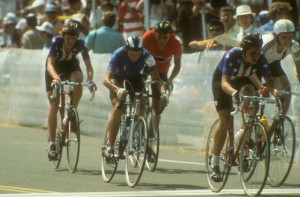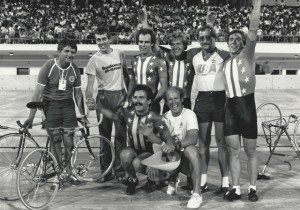Tainted Blood relives doping scandal of 1984 LA Olympics
With the 2016 Summer Olympics just four short months away, athletes from around the world are gearing up to live their dreams and go for the gold. But overshadowing the upcoming event is yet another news story of sportsmen seeking an edge through the use of performance enhancing drugs. Sadly, doping in sports is nothing new despite ongoing efforts to stamp out the practice and ensure the games are played “clean.” Journalist and Filmmaker Jill Yesko recalls one such doping scandal and recounts the sordid tale in a new documentary, Tainted Blood: The Untold Story of the 1984 Olympic Blood Doping Scandal. Jill recently shared the story behind the making of Tainted Blood in her initial print interview with the Baltimore Post-Examiner.
BPE: Thank you for speaking with us today. You’ve directed and produced a new documentary about an unusual doping scandal that engulfed the U.S. cycling team after the 1984 Olympics. Tell us how you became interested in this project.
Jill: I was a national class cyclist all throughout the 1980’s. From 1983-84 I lived in Los Angeles. This was during both the run-up to and playing of the ‘84 Olympic games. I was also racing bikes at the time, so it was just fantastic to have the Olympics in my adopted hometown of L.A. I went to the events and watched the United States win an unprecedented number of cycling medals. The United States had not won a cycling medal since 1912. It was exciting to watch our team win so many medals – especially Alexi Greywal who came out of nowhere to win the gold in the Olympic road race. He was a total underdog, but he out sprinted the heavily favored Canadian racer, Steve Bower. It was like David slaying Goliath.

But then, the letdown happened. Five months later a scandal broke.
I read that members of the team had blood-doped at the Olympic Games. I had never heard of blood-doping, though I knew about steroids and other drugs. But this just seemed so farfetched; that members of the team would receive blood transfusions in their hotel rooms.
They did this, too, at a time when we didn’t know much about HIV/AIDS, so they’re lucky that nobody died or developed AIDS.
So, I thought about this story that happened long before Lance Armstrong was revealed to have used any number of performance enhancing drugs. Once I became a journalist, I knew this was a good story. It’s just taken me a very long time to bring it to fruition.
BPE: When you say blood-doping, what exactly is involved with that?
Jill: Blood-doping means that you inject very oxygen rich red blood cells into your veins and it gives you a huge boost. It’s like training at a high altitude without having to travel to Colorado. These days nobody blood-dopes because you can use artificial means to get the same result. That’s called EPO (erythropoietin) – it’s what Lance Armstrong did. But we were much less sophisticated in 1984. The thing is – and I make a point about this in my film – at the time, blood-doping (it was called blood-boosting) was technically not illegal. It wasn’t made illegal until after the scandal broke. Still, it was in that very gray area. The cyclists and their coaches were told by the governing body NOT to engage in blood-boosting. But our team did it anyway.
BPE: Were other teams or individual cyclists caught up in the scandal?
Jill: Oh my God, cyclists have been cheating since day one. In the 1970’s, the Belgian and Dutch cyclists were notorious for using any number of drugs ranging from more-or-less benign drugs like caffeine to things like animal tranquilizers. There’s something known as the “pot belge”, which means they would take a number of drugs – not necessarily even knowing what they are – then mix them all together and hope for the best. In fact, Tom Simpson was a British rider who died on one of the steepest climbs to Mount Ventoux. It was said that he had a heart attack, but an autopsy revealed that he had taken any number of drugs which could have brought on the heart attack. That was in 1967. The sad thing is, until the 1984 Olympics, American cyclists had been considered clean. There may have been a few doing stuff under the radar, but ‘84 was the first time our team had a doping program. It may have been the kindergarten version of what Lance Armstrong did, but my film makes the point that it was the beginning of a ride down that slippery slope.
BPE: The scandal hit five months after the games. What, if anything, came of it? Did anyone lose their medals, or is this a case where all that happened was that type of doping was banned?
Jill: The thing about the dopers in every sport is they are just half a step ahead of detection. What may be legal today may be illegal in six months. As for the consequences, the big fear was the athletes would have to give back their medals.

But that didn’t happen.
The coaches and some of the other people involved were basically given a slap on the wrist. One of the points I make in the movie is that even today, sports governing bodies are not very serious about making sure the games are clean. There’s a good reason for that. There are huge amounts of money to be gleaned from sponsors. I believe one of the things which made the 1984 Olympics unique was that it was the first truly corporate Olympics.
Peter Uberoth, who ran the Olympics, was given a mandate to turn a profit, so he invited large corporations to sponsor the Olympics. They brought in a lot of money, but with more money comes more problems and more pressure. The US team was sponsored by the Southland Corporation, who was then the parent company of 7-11. Southland built the velodrome where the bike races happened, so of course they wanted their riders to be successful. They even nicknamed our team “Team Slurpee”.
BPE: This was 1984 – after the boycott of the 1980 Olympics. So I guess the combination of corporate sponsorship and having the games played stateside kicked things up a notch?
Jill: Oh, the ‘USA All The Way’ hype was off the scale in Los Angeles. The boycott in 1980 was some sort of statement by Jimmy Carter against the Soviet Union invasion of Afghanistan. Of course, in ‘84 the Soviets and their satellites returned the favor in kind, so the United States was favored to win many medals. It was a very jingoistic time; that was the back beat driving the ‘84 Olympics.
BPE: You subtitled your film, “The Untold Story”. Is that because the investigation happened after the Olympics and then the story just went away?
Jill: We tend to think that, prior to the invention of the internet, stuff just didn’t happen. I believe that the Lance Armstrong story was huge, not only because he a was Tour de France rider, but because we had the internet and social media. We had a much more developed press corps. Compared to today, 1984 was the Dark Ages. Most of the reporting of the story was done in print, and because so many newspapers have gone out of business, I’ve had a hard time tracking down some of the archival sources. It was also more than a generation ago, so people forget that this doping scandal even happened. The fact that it’s still happening today in other sports, such as the scandal that has just broken in tennis, underscores the relevance of this project.
BPE: If nothing too harsh happened to either the riders or the coaches, were they allowed to return to compete in 1988?

Jill: For some of the riders, ‘84 was a do-or-die Olympics because they had made the 1980 team but weren’t allowed to participate, due to the boycott. Others just moved on. One of the riders from the ‘84 team who was not involved in the blood doping – silver medalist Dave Grills – told me he knew of one rider who was so troubled at being caught up in the scandal, that he just put his medal in a drawer and never looks at the thing.
BPE: How many riders were accused of doping?
Jill: There were eight in all; seven men and one woman. It was not the whole team. I’ve managed to talk to some of the riders; I’ve talked to the team manager and the team coach; and it just feels like Rashamon to me. Everyone is telling me a different version of what happened. I doubt I’ll ever really get to the truth. At this point, everyone is doing legacy protecting. No one is denying that this happened, but when I ask whose idea it was, everyone points a finger at somebody else.
BPE: How far along is the film?
Jill: The film is in production; the trailer is done, and I am working on a rough cut. I had hoped to have the rough cut done in time for this year’s summer Olympics in Rio. I’m not sure if it will be done by that time, but I am hoping for a general release in 2017. This is how it goes with a labor of love.
BPE: May I ask how you are financing this?
Jill: Right now, I’m in the middle of an Indigogo campaign. We’re about a 1/3 of the way to reaching our goal, but the clock is ticking. We’ll do another campaign once the rough cut is complete; just something to clean up the final product and find a great distributor. My ideal is that the film is picked up by ESPN as one of their 30/30’s. That’s how I directed it. But I would just be very happy if cyclists and the general public saw it and appreciate the message.
BPE: Can you tell us if any of the people you approached about this film were hostile?

Jill: Oh, my gosh, yes. (Laughing) Yes, I can. I called up Steve Hegg – one of the gold medalists from that team – and he was openly hostile. He even said, “I’ve given thirty years of my life to this sport and gotten nothing. If you want me to be in this film, you’ve got to pay me.” I told him I don’t do that. I’ve been flamed by internet trolls; I’ve been threatened with law suits by some of these athletes. It’s been tough, but I’ll tell you, featured in my movie is Betsy Andreu. She’s the wife of Frankie Andreu, who was Lance Armstrong’s teammate for many years.
Betsy is herself a whistle blower. She’s been subjected to death threats and lawsuits for exposing Lance Armstrong. Betsy is my role model, and she has been extremely helpful and encouraging in getting me to stick to my guns and complete this project.
When it comes to doping in cycling, there is still a huge code of Omertà that governs the sport. You just don’t rat people out. If you do, you have to be prepared to pay the consequences. There have been well-documented cases of Tour de France riders who have come out and said, “I’m a clean rider”, and the pack has turned on them. I would hope that, through my film and the continued efforts of the anti doping movement, it will not only be easier to speak out and be a whistle blower but also to ride or run or play your sport clean, without the fear that your teammates are going to turn on you.
BPE: You’ve gotten blowback from some of the team members. What about the Olympic Commission?
Jill: So far, I have heard nothing from them. I have also been unable to license any official Olympic film footage. I suspect when my film is released, I won’t get the warmest reception from anyone affiliated with either the United States or International Olympic Committees.
I have approached both USADA (United States Anit-Doping Association) and WADA (World Anti-Doping Association) about sponsoring my project. These organizations arose in the wake of Lance Armstrong. They advocate for better testing, better education and more transparency in the world of sports.
BPE: Do you believe mid-level riders should be on board with testing, because it helps them advance through the ranks; that the tests help to create a level playing field?
Jill: Yeah, I’m not so naive to think that there will ever be a level playing field. People are always going to game the system. That said, if you can eliminate 50% of the drugs in cycling, it will give mid-level cyclists a greater chance of succeeding. You know, everybody is looking for that edge. Sometimes in cycling, even at the end of a Tour de France stage, it might come down to just a sprint at the end. So if the person you’re sprinting with isn’t taking drugs, you might have a chance of wearing the yellow jersey that day.
(Banner photo “Blood Rings” courtesy University of Utah)

Anthony C. Hayes is an actor, author, raconteur, rapscallion and bon vivant. A one-time newsboy for the Evening Sun and professional presence at the Washington Herald, Tony’s poetry, photography, humor, and prose have also been featured in Smile, Hon, You’re in Baltimore!, Destination Maryland, Magic Octopus Magazine, Los Angeles Post-Examiner, Voice of Baltimore, SmartCEO, Alvarez Fiction, and Tales of Blood and Roses. If you notice that his work has been purloined, please let him know. As the Good Book says, “Thou shalt not steal.”
